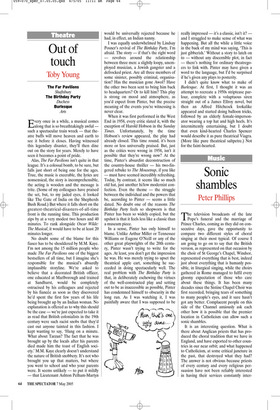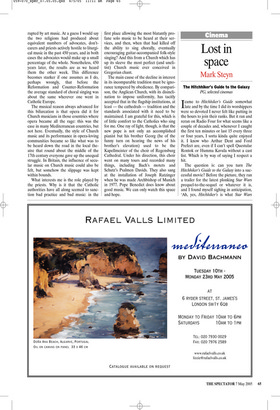Sonic shambles
Peter Phillips
The television broadcasts of the late Pope’s funeral and the marriage of Prince Charles, coming as they did on consecutive days, gave the opportunity to compare two different styles of choral singing at their most typical. Of course I am going to go on to say that the British version, as represented on that occasion by the choir of St George’s Chapel, Windsor, represented everything that is best, indeed just about everything that is humanly possible, in liturgical singing, while the choirs gathered in Rome managed to fulfil every gloomy expectation of those who care about these things. It has been many decades since the Sistine Chapel Choir was first recorded, bringing tears of something to many people’s eyes, and it sure hasn’t got any better. Complacent people on this side of the Channel anxiously ask each other how it is possible that the premier location in Catholicism can allow such a sonic shambles.
It is an interesting question. What is there about Anglican priests that has produced the choral tradition that we have in England, and have exported to other countries in our near orbit; and what happened to Catholicism, at some critical juncture in the past, that destroyed what they had? The answer is not obvious because priests of every century and every religious persuasion have not been reliably interested in having their services constantly inter rupted by art music. At a guess I would say the two religions had produced about equivalent numbers of advocates, don’tcarers and priests actively hostile to liturgical music in the past 450 years, and in both cases the advocates would make up a small percentage of the whole. Nonetheless, 450 years later, the results are as we heard them the other week. This difference becomes starker if one assumes as I do, perhaps wrongly, that before the Reformation and Counter-Reformation the average standard of choral singing was about the same wherever one went in Catholic Europe.
The musical reason always advanced for this bifurcation is that opera did it for Church musicians in those countries where opera became all the rage: this was the case in many Mediterranean countries, but not here. Eventually, the style of Church music and its performance in opera-loving communities became so like what was to be heard down the road in the local theatre that round about the middle of the 17th century everyone gave up the unequal struggle. In Britain, the influence of secular music on Church music could also be felt, but somehow the slippage was kept within bounds.
What interests me is the role played by the priests. Why is it that the Catholic authorities have all along seemed to sanction bad practice and bad music: in the first place allowing the most blatantly profane solo music to be heard at their services, and then, when that had killed off the ability to sing chorally, eventually encouraging guitar-accompanied folk-style singing? And this from a Church which has up its sleeve the most perfect (and unelitist) Church music ever conceived in Gregorian chant.
The main cause of the decline in interest in its incomparable tradition must be ignorance tempered by obedience. By comparison, the Anglican Church, with its disinclination to impose uniformity, has tacitly accepted that in the flagship institutions, at least — the cathedrals — tradition and the standards associated with it need to be maintained. I am grateful for this, which is of little comfort to the Catholics who sing for me. One ray of light, though, is that the new pope is not only an accomplished pianist but his brother Georg (he of the funny turn on hearing the news of his brother’s elevation) used to be the Kapellmeister of the choir of Regensburg Cathedral. Under his direction, this choir went on many tours and recorded many things, including Bach’s motets and Schutz’s Psalmen Davids. They also sang at the installation of Joseph Ratzinger when he was made Archbishop of Munich in 1977. Pope Benedict does know about good music. We can only watch this space and hope.




























































 Previous page
Previous page